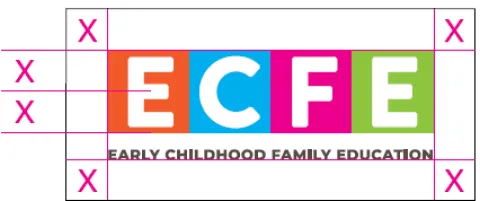Learn about the impact of the federal shutdown on SNAP and other DCYF programs.
ECFE Wordmark and Guidelines
ECFE wordmark
The ECFE wordmark options below are approved and available for use in all design materials. While the color version is included in the samples provided, other versions are available for download in multiple formats (EPS, JPG, PNG) using the links below. This includes black and white, gray scale and reversed wordmark options.
Note: This is not a state wordmark. It is a wordmark treatment available for you to help build awareness of your ECFE program.
Guidelines
Correct wordmark usage

Primary full-color
The standard full-color wordmark should be used whenever possible on digital and print media.

Black and white
Use this wordmark version only when black and white printing is the only option.

Reversed
The reversed wordmark should only be used over a dark background.
Incorrect wordmark usage
It is important to maintain the integrity and consistency of the ECFE wordmark.
The wordmark must:
- Always be presented in a clear and legible manner
- Always be reproduced from the approved files
- Not be altered in any way
Additional factors to consider when using the wordmark include colors, backgrounds and the clear zone. Although not an exhaustive list, below are common incorrect uses of the wordmark.
Do not alter the color.

Do not alter the proportion.

Do not separate the wordmark.

Do not rotate the wordmark.

Do not recreate the wordmark.

Do not place the wordmark on a pattern.

Clear field
Always leave space around the ECFE wordmark equal to half the height of the box in the wordmark (marked as “X”). Keep this area free of any text, images or other graphics.

Minimum size
For the greatest impact and readability, a minimum wordmark size has been established. This is the smallest size at which the wordmark should ever be reproduced. Smaller versions are difficult to read. The minimum size of the identity is based on its width; it should never be less than one inch.
Color palette

The identity should be printed in the approved ECFE colors.
The CMYK colors are the preferred color combinations for all the colors chosen. Use color text for headlines only.
Web-safe colors pass WCAG AA color contrast guidelines for text on a white background or reversed out with white text.
- Orange
- CMYK: 0, 80, 95, 0
- RGB: 241, 90, 41
- HEX #: F15A29
- Blue
- CMYK: 100, 0, 0, 0
- RGB: 0, 174, 239
- HEX #: 00AEEF
- Pink
- CMYK: 0, 100, 0, 0
- RGB: 236, 0, 140
- HEX #: EC008C
- Green
- CMYK: 50, 0, 100, 0
- RGB: 141, 198, 63
- HEX #: 8DC63F
- Brown
- CMYK: 55, 60, 65, 40
- RGB: 89, 74, 66
- HEX #: 594A42
- Black
- CMYK: 0, 0, 0, 100
- RGB: 0, 0, 0
- HEX #: 000000
Fonts
Fonts in Microsoft Word templates
The Microsoft Word templates use the Calibri font family. Always apply the designated headline and body text styles included in the files.
Note: For printed materials (posters, postcards, rack card and tabletop easel board), headlines are locked and cannot be edited.
Fonts in InDesign templates
The InDesign templates use the Brandon Grotesque font family. Always apply the designated headline and body text styles included in the files.